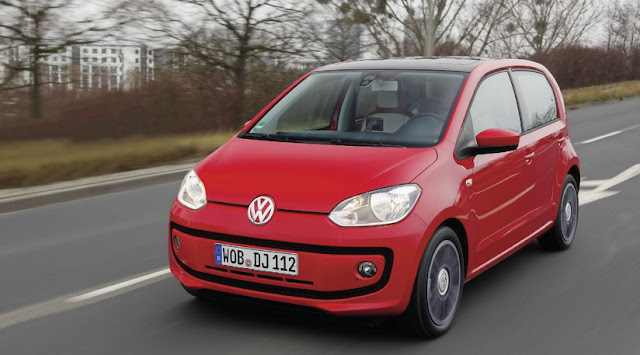This is the Volkswagen Up, a little city car we’ve been excited about ever since the first rear-engined and rear-wheel drive concept was unveiled in 2007. Alas a layout akin to the original people’s car (the Beetle) proved too expensive to develop in the 21st century, so the production car is standard urban runabout fare – i.e. front-engined and front-wheel drive.
But the massive economic of scale (VW subsidiaries Seat and Skoda are also producing their own versions) mean the Up might be able to deliver all the qualities so beloved of Volkswagen at a price point us plebs can actually afford – prices start at under £8k. There’s a three-door version, and for just a few hundred quid more there’s the five-door tested here, which 52% of customers are expected to opt for.
I’m excited about this little city car. What’s the VW Up 5dr like?
The front and rear styling of the Up 5dr remains the same as the 3dr, which means a smiling mouth and darkened glass bootlid. But there’s change between the B- and C-pillars: the lower window line no longer kicks upwards towards the rear, but now runs straight back.
VW reckons the 5dr will carry a mere £375 premium over the 3dr in the UK, helped by the back windows only being pop-out items. Boot space remains identical to the 3dr Up, at 251 litres, or 951 litres with the rear backrest folded down. There’s only room for two in the back, but there is plenty of space for rear seat passengers’ feet beneath the front seats.
What about the interior?
Great. The dials are clear, the air-con and radio controls are grouped high rather than clustered down behind the gearstick, and the (optional) Maps+More portable touchscreen sat-nav and infotainment system that snaps into place atop the dash is easy to use. Headroom is plentiful, the seats are comfortable, and there’s plenty of room too. Just like in the Fiat 500 a big slab of glossy plastic helps lift the ambience, but the quality of the plastics and the refinement levels are ahead of the Italian.
It might be a small car but there are big car features – which are optional, of course. The City Emergency Braking system does what it says on the tin, braking the Up if speeds are between 3mph and 18mph (it’s a more rounded 5-30km/h if you live on the Continent), and you can spec a panoramic tilt and slide sunroof too.
There are five versions of the Up available…
The entry-level Take Up with 14in wheels, ABS, power-assisted steering, daytime running lights, a folding rear bench, and body coloured bumpers.
The Move Up with body coloured wing mirrors and door handles, gloss back interior highlights, remote central locking, air-con, front electric windows, a 60:40 split rear bench and ESP.
The High Up (which we’ve tested) with 15in wheels, fog lights, Maps+More, heated front seats, electric and heated door mirrors, air-con, MP3 connectivity and a leather-adorned steering wheel and handbrake.
The Up Black and Up White (VW UK has wisely reversed the names) are based on the High Up but come with 16in wheels, chromed wing mirrors and side strips and tinted rear glass – and obviously one is black inside and out and the other is white.
And to drive?
There are just two engines available, both 1.0-litre triples but in different states of tune. There’s 59bhp (for the Take Up and Move Up) or 74bhp (for the others) to choose from, with power going to the front wheels via a five-speed manual or five-speed automatic gearbox. And there’s a Bluemotion Technology version of the 59bhp model (only available in Move Up guise) with stop/start, a trick alternator, low-friction engine ancillaries and low rolling resistance tyres to shift the figures from 62.8mpg and 105g/km to 68.9mpg and 96g/km CO2.
And unless you can’t drive with three pedals, don’t opt for the automated manual gearbox. VW reckons a DSG ‘box would cost around £1500 and a conventional torque converter would be a £1200, so the estimated £800 means it’s a cheaper alternative. But it’s jerky and ponderous and quite possibly the worst example of an automated manual I’ve ever tried. Lifting as you shift limits the head nodding, but then that’s not really the point of an auto.
But the manual version is excellent. The gearbox is light and slick (as is the steering), the engine thrums away happily without becoming tiresome and intrusive (a la Aygo/107/C1), the ride is comfortable and supple, and visibility is very good. Refinement levels are high too, so 80mph on the autobahn is handled with ease, and while you need to drop down a gear or two to make any progress, overall it’s a wonderful little package.
Anything else?
We also tested the Cross Up, a jacked-up Allroad-esque version of the 5dr with raised suspension, faux off-road cladding and flared wheelarches. To drive it’s all but identical to the normal 5dr, but at least to these eyes the visual tweaks add a little visual flare to offset the more grown-up image created by the extra pair of doors. Pity it won’t be sold in the UK.
Verdict
Whereas the Toyota iQ failed to live up to its hype (actually too small, too compromised, too dull) the Up, while not radical, is everything we’d hoped for. It looks cool, it’s fun to drive, plus it banishes memories of the VW Fox and is a city car dripping with quality and worthy of wearing the VW badge. There’s no reason to spend more on the Polo, and while that, the Golf and Passat can be dreary and dull, this is a Volkswagen that’s actually exciting.



No comments:
Post a Comment